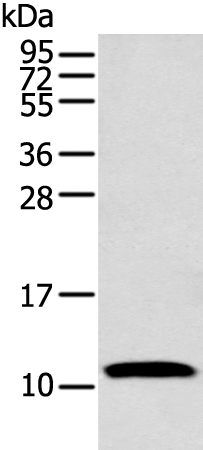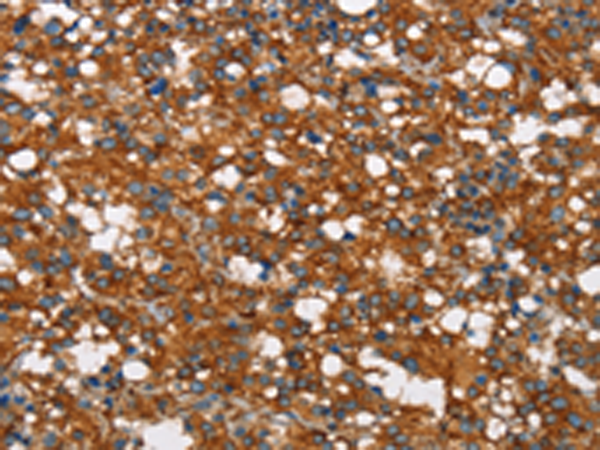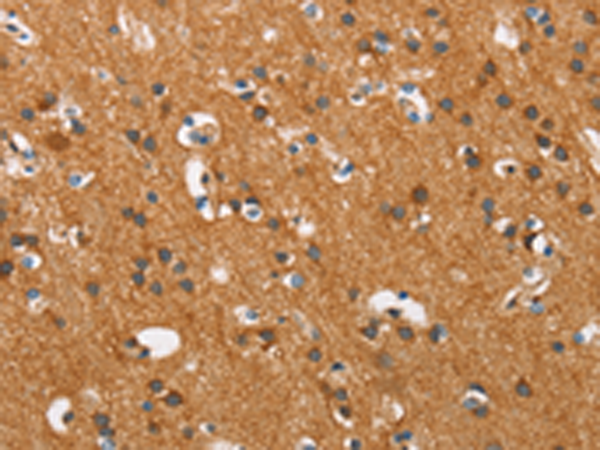


| WB | 1/500-1/1000 | Human,Mouse,Rat |
| IF | 咨询技术 | Human,Mouse,Rat |
| IHC | 1/50-1/100 | Human,Mouse,Rat |
| ICC | 1/50-1/200 | Human,Mouse,Rat |
| FCM | 咨询技术 | Human,Mouse,Rat |
| Elisa | 咨询技术 | Human,Mouse,Rat |
| Aliases | VA; COX; COX-VA |
| WB Predicted band size | 17 kDa |
| Host/Isotype | Rabbit IgG |
| Antibody Type | Primary antibody |
| Storage | Store at 4°C short term. Aliquot and store at -20°C long term. Avoid freeze/thaw cycles. |
| Species Reactivity | Human, Mouse, Rat |
| Immunogen | Synthetic peptide of human COX5A |
| Formulation | Purified antibody in PBS with 0.05% sodium azide and 50% glycerol. |
+ +
以下是3篇关于α-SMA抗体的经典文献摘要概括:
1. **"The myofibroblast: one function, multiple origins"** (Hinz B, et al., 2007)
- 摘要:探讨肌成纤维细胞(myofibroblast)中α-SMA的表达及其在组织收缩和纤维化中的作用,强调α-SMA抗体在区分不同细胞表型(如成纤维细胞与肌成纤维细胞)中的关键应用。
2. **"Myofibroblasts and mechano-regulation of connective tissue remodelling"** (Tomasek JJ, et al., 2002)
- 摘要:综述α-SMA在肌成纤维细胞中的功能,及其在伤口愈合和纤维化疾病中的动态表达,提出α-SMA抗体是研究细胞机械转导和细胞外基质重塑的重要工具。
3. **"Tissue repair, contraction, and the myofibroblast"** (Desmoulière A, et al., 2005)
- 摘要:分析α-SMA抗体在定位肌成纤维细胞中的应用,揭示其在病理状态(如肝纤维化、肾纤维化)中的标志性作用,并讨论其表达调控机制。
4. **"Cancer-associated fibroblasts as targets of anticancer therapy"** (Heldin CH, et al., 2012)
- 摘要:研究肿瘤微环境中α-SMA阳性癌症相关成纤维细胞(CAFs)的促癌作用,强调α-SMA抗体在肿瘤组织染色及预后评估中的临床应用价值。
以上文献均聚焦α-SMA抗体在基础研究与疾病模型中的核心作用,涵盖纤维化、肿瘤及组织修复等领域。
Alpha smooth muscle actin (α-SMA) is a cytoskeletal protein predominantly expressed in smooth muscle cells and myofibroblasts. As a member of the actin family, it plays a critical role in cell contraction, motility, and structural integrity. The α-SMA antibody is a widely used tool in research and diagnostics to identify cells exhibiting smooth muscle-like properties, particularly in pathological conditions involving tissue remodeling.
In normal physiology, α-SMA is abundant in vascular smooth muscle cells, myoepithelial cells, and visceral smooth muscle. Its expression is upregulated in activated myofibroblasts during wound healing, fibrosis, and cancer progression, making it a key marker for studying fibrotic diseases (e.g., liver cirrhosis, pulmonary fibrosis) and tumor stroma. The antibody is essential for distinguishing myofibroblasts from fibroblasts, as α-SMA is a defining feature of their contractile phenotype.
Commonly used in techniques like immunohistochemistry, immunofluorescence, and Western blot, α-SMA antibodies (e.g., clone 1A4) help visualize spatial distribution and quantify protein levels in tissues or cultured cells. Their specificity is validated using knockout controls or peptide blocking assays. Clinically, α-SMA staining aids in diagnosing smooth muscle tumors, assessing vascular pathologies, and monitoring fibrotic progression. However, interpretation requires context, as transient α-SMA expression can occur in non-muscle cells during stress or inflammation. Research continues to explore its role in cellular mechanotransduction and therapeutic targeting of fibrosis.
×